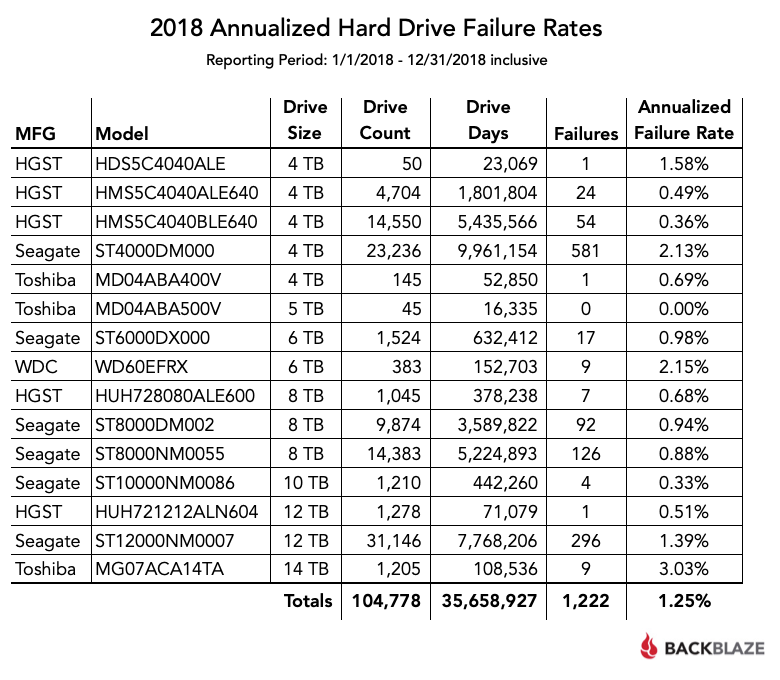Backblaze released HDD reliability statistics for 2018

More than five years ago, Backblaze published its first report on the use of disk drives in its servers. Backblaze provides a cheap cloud backup service. At the heart of their infrastructure are consumer-grade hard drives. The company has collected large statistics on the fault tolerance of various types of HDD. Backblaze drives at the time consisted mainly of Seagate, Hitachi, and WD drives, while Hitachi drives were the most reliable.
Since then, Backblaze has been publishing statistics annually, and now it's time for the next report .
As of December 31, 2018, the company had 106,919 active HDDs, of which 1965 were boot disks and 104 954 data disks. The review shows the failure rates of hard drives with data in the company's data centers. New HDD models that were added to the server racks during 2018, including the 12 TB HGST model and the 14 TB Toshiba model, are also considered. It is clear that a lot of statistics have not yet been collected on the new models, because they have been installed only recently and the number is small. So it’s too early to finally bury, for example, the Toshiba MG07ACA14TA model with a bounce rate of 3.03% (if we bring it to an annual basis). Maybe the unsuccessful game just came across.
The table shows only those models for which statistics are collected from at least 45 copies (some of these drives were used just for testing). The number 45 is the minimum amount needed to fill one Backblaze Storage Pod in the data center. Thus, out of 104,954 hard drives, 104,778 were left for statistics analysis.

Note: an annual failure rate of 0.00% means that during 2018 there were no failures
Backblaze experts admit that at the end of 2018, the overall annualized failover rate (AFR) turned out to be very good: only 1.25%. For comparison, in 2013 the numbers were much worse, and some Seagate models then rained down to AFR 25.4% (Seagate Barracuda 7200 model, ST31500341AS). The second and third years of operation then became especially critical for Seagate discs.

Statistics from the first Backblaze report for 2013.
Now all models have proved to be very reliable drives. The exception is cases when there were a small number of copies of a particular model (less than 500) and / or they all worked together a small number of days (less than 50,000). In these cases, AFR cannot be considered reliable for making purchase decisions.
The total AFR for all models for the year was only 1.25%, which is significantly lower than in previous years.
Backblaze writes that in 2018, a noticeable trend was the replacement of old 2, 3, and 4 TB drives with 8, 10, 12 drives, and another 14 TB in the fourth quarter. We can assume that this trend is characteristic not only for Backblaze, but also for the entire consumer market: many users made such an upgrade last year. In 2018, Backblaze's total storage capacity grew from 500 to more than 750 petabytes, with an average of 75 drives added per day.
After last year’s upgrades, Western Digital’s disks were almost gone, now only 383 units work, all 6 TB, this is only 0.37% of the total number of drives.
Backblaze notes good performance discs HGST (model HUH721212ALN604). During the first month of testing of 1200 such drives, only one failure was registered, so the company decided to increase their fleet. But the most popular disk in the data center was the 12 TB Seagate model (ST12000NM0007), which runs 29.7% of the farm.
The following table compares AFR by year and shows how much more reliable the disks have become in 2018: the number of failures has been steadily decreasing for the third year in a row.

Another interesting observation: none of the 45 Toshiba 5 TB drives have failed since the second quarter of 2016 (model MD04ABA500V). The reliability of 10 TB Seagate drives (model ST10000NM0086) with AFR over the past year of only 0.33% also continues to impress, with 1220 drives operating in total for about 500,000 days, so the statistics are quite reliable.
Finally, the last table shows the failure rates of hard drives for all the time since April 2013 - for those models that are still in operation.

The full dataset for this review is published here . If you only need the tables from this article, you can download the CSV file with the data.
